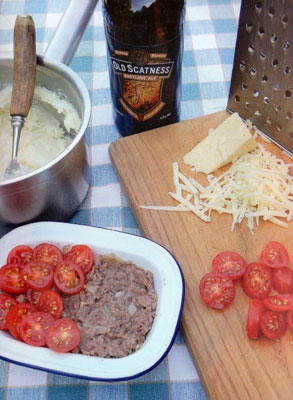Sassermaet clatch
In Shetland dialect, clatch translates roughly as a smear; something clatchy is sticky. This dish does not quite match either definition, although the name is evocative enough of the highly spiced pie topped with potato “similar in principle,” according to Marian Armitage, “to a shepherd’s pie.” Sassermaet is the old spelling of saucermeat, the heavily spiced ground beef or less commonly lamb or mutton ubiquitous to Shetland kitchens. Our recipe is adapted from Shetland Food and Cooking by Armitage, who celebrates Shetland foodways but is no slave to the past. The optional tomato slices are decidedly nontraditional, and a typical Armitage touch. You will need a pound of saucermeat for the clatch; the bfia formula also is posted in the practical. For four.

- unsalted butter for greasing the dish
- 1 lb saucermeat
- a diced onion
- 2 beaten eggs
- sliced tomato rounds to cover the filling (optional)
- about 1½ lb potatoes, mashed with butter, milk and 2 teaspoons mustard
- about ¼ lb grated Cheddar or other hard British cheese
Preheat the oven to 350˚.
- Grease an ovenproof pie pan or dish.
- Brown the saucermeat over medium high to high heat in a big heavy skillet, then add the onion, reduce the heat to medium and cook the mixture until the onion softens
- Let the mixture cool, fold in the eggs and dump the mixture into the dish.
- Top the saucermeat mix with the tomato if you choose to use it, and the tomato in turn with the mashed potato, and top the potato in turn with the cheese.
- Cook the clatch until it becomes brown and bubbly, usually in about half an hour.
Notes:
-The filling requires neither salt nor pepper because both seasonings are pronounced in saucermeat.
-You should of course season your mashed potato.
-Cooked chopped carrot and turnip, perhaps a scant ¾ cup of each, would make a companionable and traditionally Scots addition at the end of Step 2 instead of the tomato.

